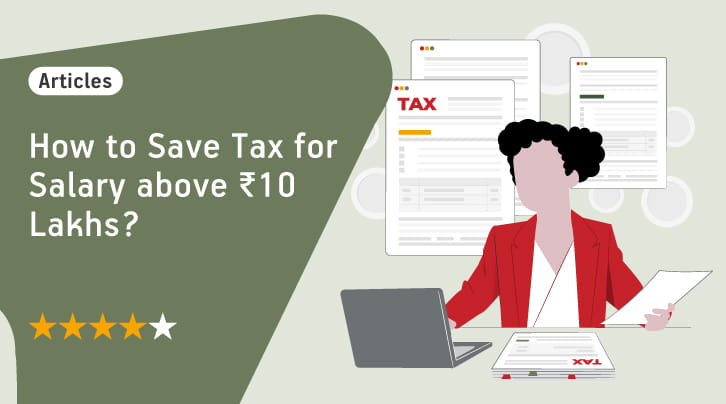-
Our Products
Our FundsFocus Funds
-
Self Care
Self-ServiceFind InformationWays To TransactPartner Solutions
-
Downloads
- Learnings
- About Us
-
More
-
Shareholders
-
Shareholders
-
Updates
-
-
SIP Calculators
- Back
-
Shareholders
How to Save Tax on Salary Above 10 Lakhs?

Nov 07, 2023
5 min
4 Rating
The Old and New Income Tax Regime
Your tax-saving initiatives will abundantly depend on the tax regime you choose for calculating your taxes. Here’s a quick overview of the old and new tax regimes-
Income Tax Slabs |
Old Tax Regime |
New Tax Regime for FY2023-24 (After Budget 2023) |
Up to ₹2.5 lakhs |
NIL |
NIL |
₹2.5 lakhs - ₹3 lakhs |
5% |
NIL |
₹3 lakhs - ₹5 lakhs |
5% |
5% |
₹5 lakhs - ₹6 lakhs |
20% |
5% |
₹6 lakhs - ₹7.5 lakhs |
20% |
10% |
₹7.5 lakhs - ₹9 lakhs |
20% |
10% |
₹9 lakhs - ₹10 lakhs |
20% |
15% |
₹10 lakhs - ₹12 lakhs |
30% |
15% |
₹12 lakhs - ₹12.5 lakhs |
30% |
20% |
₹12.5 lakhs - ₹15 lakhs |
30% |
20% |
Above ₹15 lakhs |
30% |
30% |
Saving Tax on Salary Above ₹10 Lakhs
The gross profit ratio (GP ratio) is a financial ratio that Compared to the older tax regime, the new regime has lower tax rates for most income slabs. However, the older regime offers a host of exemptions and deductions not available in the newer regime.
So, the first step to saving income tax for ₹10 lakhs is to choose a regime that provides you with maximum savings. And in order to make this selection, you should know the various exemptions and deductions available under the older tax regime.
Also Read – Income Tax Slabs
Exemptions and Deductions Under Old Tax Regime
For a salaried employee, these are some of the most common exemptions and deductions available under the old tax regime-
Exemptions Under Old Tax Regime
Salary Component |
Taxability |
Standard Deduction (section 16) |
₹50,000 |
HRA (House Rent Allowance) (section 10(13A)) |
Up to a certain limit |
LTA (Leave Travel Allowance) (section 10(5)) |
In 4 years, the travel expenses of 2 trips are exempt under Section 10(5) of Income Tax Act, 1961 |
Mobile/Internet Reimbursement (Section 10(14))> |
Exempt if predominantly used for work purposes |
Food (Section 10(14)) |
Up to ₹31,200 in a year |
Professional Tax (Section 16) |
Varies between states but is generally around ₹2,500 |
Child Education Allowance (Section 10(14)) |
₹,100 per month per child for a maximum of 2 children |
Child Hostel Allowance (Section 10(14)) |
₹300 per month per child for a maximum of 2 children |
Deductions Under Old Tax Regime
Exemptions and Deductions Under New Tax Regime
Almost all the exemptions and deductions common among salaried taxpayers under the older regime are not available with the new regime. Some of the deductions available under the new regime are as follows-
Standard deduction of ₹50,000
Employer’s NPS contribution under Section 80CCD(2) of Income Tax Act, 1961
Interest on home loan on let-out property under Section 24 of Income Tax Act, 1961
Exemption on voluntary retirement 10(10C), gratuity u/s 10(10) and Leave encashment u/s 10(10AA)
What Should You Choose Between Old and New Regime to Save Tax on Salary Above ₹10 Lakhs?
Let’s try to understand the calculation of tax for ₹10 lakhs under the old and new regimes with an example-
Mr Rajiv has an annual salary income of ₹12.5 lakhs. Here's how his income tax will be calculated under the old and new tax regimes, assuming he wants to claim some of the exemptions and deductions available under the older regime-
Particulars |
Old Tax Regime |
New Tax Regime |
Annual Income |
₹1,250,000 |
₹1,250,000 |
Standard Deduction |
₹50,000 |
₹50,000 |
HRA |
₹100,000 |
- |
LTA |
₹20,000 |
- |
80C (Investments) |
₹150,000 |
- |
80D (Health Insurance) |
₹50,000 |
- |
Net Taxable Income |
₹870,000 |
₹1,200,000 |
Income Tax |
₹79,560 |
₹119,600 |
Disclaimer: The above illustration is Only for representation purposes. Actual calculations depend on salary, salary structure, investments, purchases, etc.
So, in the example above, Mr Rajiv, with his annual salary of ₹12.5 lakhs, could pay lower taxes with the older tax regime. However, this might not be the case for every salaried individual having a salary of ₹10 lakhs or above. The tax liability could also be lower with the new regime in many cases. Consult with a tax advisor to select between the old and new regimes.
Reducing Your Tax Liability on Salary of Above ₹10 Lakhs
While the old regime has many exemptions and deductions to reduce tax liabilities, the newer regime has lower tax rates. Now that you know how to save tax on a salary of above ₹10 lakhs, use this information to select a regime that offers maximum tax benefits.
But as income tax calculation varies on a case-to-case basis, it’d be advisable to consult to a tax advisor who can help you make the right selection.
Mutual Fund investments are subject to market risks, read all scheme related documents carefully.





 1800-270-7000
1800-270-7000



